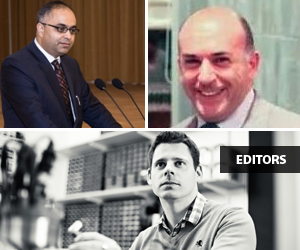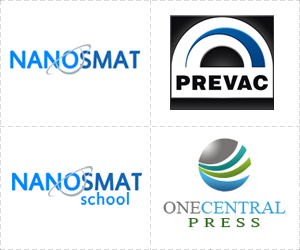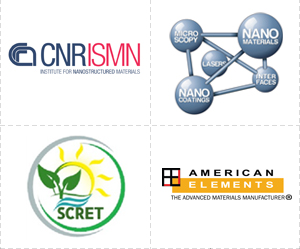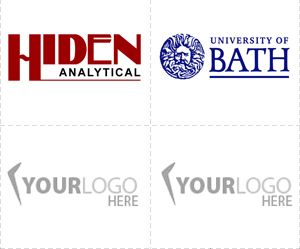An Interview with Professor Alexander Seifalian
There is a big interest in Nanotechnology research worldwide. Nanotechnology is a multidisciplinary field so it’s always interesting to get an idea of the background of scientists and their major influences early on in their career. Could you tell us about your experiences in Nanotechnology and what advice would you give to someone who wants to enter Nanotechnology?
Nanotechnology is a very interesting field of research and it has huge potentials and many benefits that can be useful to the society we live in and that can improve the quality and lifetime of us humans. Many people are trying to get into this field and want to work in nanotechnology. I often get emails from all over the world from students who want to enter nanotechnology and more specifically the emerging and important field of nanomedicine. They ask me about what to study at the undergraduate and postgraduate levels. The answers to these questions are difficult and challenging. Although I love to encourage young people to enter this fascinating field, however, I do not want to mislead them in any way. Nanotechnology is an amalgamation of a number of sciences including Physics, Chemistry, Mathematics, Biology, Biotechnology, Materials science, Mathematics and others. The key is to go for a field or course which you are good at and enjoy. Even more important is to develop a solid and strong foundation of that field. This could be Physics, Chemistry, Biology or other fields. After that try to get more specialised at master level or Ph.D. level.
My degree was in Physics from Kings College London. I studied nuclear physics and some of the units I studied were pointed towards the medical field. My project was focused on the penetration of radiation in materials and their effects at the biological levels. I was extremely good at mathematical modelling which was central to my project and I used many computer languages to run the theoretical modelling. This provided me with both a strong theoretical underpinning along with robust experimental approaches. A balance that is critical for venturing into emerging new areas in nanotechnology.
What did you do after your undergraduate course?
Initially, I spent a short period of time at CERN, but came back to London and was doing lots of work as consultancy in numerically modelling mainly predicting the price of shares on the stock market. This was followed by lots of work writing software such as bibliography system and in the field of artificial intelligence. Then I decided to do medicine, although I did spend a short period of time studying medicine, but left and registered on a course in London University in Biophysics and my chosen modules were in the field of nuclear medicine. Using my theoretical modelling and scientific experimentation experience I wanted to make a difference and enhance the medical field and help people get better and stay healthy, hence my interest in nanomedicine.
What did you do after your MSc course?
Well, I got a post as a Research Fellow in Manchester Dental & Medical School, looking at Temporomandibular joint (TMJ) dysfunction. This is a problem affecting the ‘chewing’ muscles and the joints between the lower jaw and the base of the skull. My job was looking at a method to diagnose joint disease and investigating EMG signals coming from muscle and the effect of the signal from the diseased muscle. With my background from nuclear medicine, I worked on using radioisotope to diagnose TMJ dysfunction and I also developed a system to diagnose muscle disease based on mathematical analysis of EMG signals arising from masseter muscle. These are facial muscles, which affect the TMJ. Very interesting project and with my task completed, I then got a job in London working in the nuclear medicine department.
When did you move to your current job at UCL?
I applied for a job in the Department of Surgery at the Royal Free Hospital – School of Medicine, which was part of London University. The job was basically working with a team of surgeons and scientists taking Liver transplantation to human. Initially, we were doing the liver transplant at experimental levels, basically from pig to pig. My job was looking at physiological factors such as blood flow, tissue perfusion and haemodynamic. We successfully started liver transplants in humans and currently doing an order of 75 liver transplants per year. When liver transplant became a routine operation, I moved towards the development of human organs using synthetic materials and stem cells. At this stage I used nanomaterials in the development of nanocomposite materials to use as a 3D scaffold for making organs. In the late 1990’s Royal Free joined with UCL and I moved to UCL.
What was your Ph.D. research?
My Ph.D. research was about the development of a technique to measure pulsatile blood flow in the heart as well as head and neck. There are not many techniques available to monitor the pulsatile blood flow in patients; this is one of the first techniques to measure pulsatile blood flow in the head and heart and at the same time measure the organ perfusion. Later on Philips using their x-ray scanner took up the work.
What and who were the major influences in your career?
Although I spent most of my childhood in boarding school and did not see my father much, but I would say it was my father who had major influences in my life. He did not have a formal education, but he was the most successful businessman and determined and very innovative running a successful business from huge farming to running a commercial company as well as in properties. The outcome was a huge success and his influence in my career was huge as well. At academic level in university, Professor Grant had a huge influence in my life, he made nuclear physics lectures so interesting and fascinating, which made anyone look forward to attending the undergraduate lectures. My first research work was with Prof Grant looking at the interaction of microwaves with biological materials, in which we used brain. He was working theoretically as well as experimentally. I was working simultaneously on both numerical modelling as well as experimentally. This was fascinating piecework and one I always remember. Another person in my life was Professor Rothwell, Oral Maxillofacial Consultant Surgeon at Manchester Dental and Medical School. He was a very bright and a nice man at the same time, very down to earth. I am always proud of working with him, even when I was at a very junior level he spent hours on teaching me and talking to me about life in general. He was an inspiration and a teacher.
You’re well known for your work with artificial organs, could you describe the main features of your work and its major achievements?
I always like to start from a simple principal and build it up. Our first major grant was in the development of artificial organs, funded by the Department of Health in 1997, to build living bypass grafts made up of mature cells. I worked with leading surgeons including Professors Hamilton and Walkers as well as Professors Fuller and Pegg. The work went very well experimentally using animal cells but clinically was not feasible due to people needing bypass grafts after over 50 years old and their cells were not growing as fast as young rodents.
I learnt a lot from that research and thought of developing materials that could be used as a 3D scaffold. The materials I developed with my research team were based on nanotechnology, “nanocomposite” – these materials have been used as a 3D scaffold, using a various technique of manufacturing including 3D printing. The scaffold was functionalised using biomolecules and stem cells. The stem cells grow inside and around the scaffold so they were able to perform the functions of the organ. Many researchers are working on completely biological organs, hence will take much longer to take the organs to the patient. Our approach has been with scaffolds and has proved to be a huge success and faster route to patients.
There are so many people dying from heart disease, kidney failure and cancer of various tissues and organs. How far are we from the artificial organs being available on the NHS and what major developments need to take place?
Although daily, one reads in newspapers and hears in media that there is a cure virtually for everything, and lots of new treatments including for cancer. But when it comes to reality the treatment has not changed significantly, still chemotherapy is treatment of choice post surgery for cancer and no one could make organs such as liver or kidney or heart or lung. Researchers are working in simpler organs including us, such as ear or trachea. But still none available in routine but except in compassionate cases, this is due to taking research from laboratory to clinic require huge sums of money, unless a big industry is behind the technology, it’s not easy to take it to market and available to all for use.
What major breakthrough do you expect in the field of nanomedicine and regenerative medicine?
In nanomedicine – major breakthrough will be drug delivery and treatment of cancer using nanomaterials. Example of drug delivery will be gold nanoparticle or Exosomes. The Exosomes are biological membrane vesicles measuring 30 to 100 nm. It is nano-theranostic delivery platforms for drug or gene therapy. The example of cancer treatment will be magnetic nanoparticles. The principal is first getting the magnetic nanoparticles into the tumour or cancer cells. Then apply a magnetic field, the nanoparticle will spin back and forth and generate significant heat. If many iron particles were delivered to a tumor, then you could actually cook the cancer; heat therapy, or cancer hyperthermia, works on this principle. Carbon nanotubes are also a possible option, which heat up in a similar way, using laser light.
Do you expect us to be using 3D printers to make specific organs on spec from scans of individuals such that organs are specifically tailored for a patient?
3D printing is a fascinating new technology that could revolutionise development of organs. The first clinical application has been to print model of patient’s heart valve, blood vessel or other organs. This is for the clinician, say cardiologist to help delivery of endovascular devices, especially transcatheter heart valves. The printed model of organ say heart valve is usually hard transparent plastic which clinicians can play around and see the geometry and shape of the organs before the intervention. Here in the UK at Great Ormond Street Hospital for Children it’s a common practice for delivery of transcatheter heart valves. The data set required for printing currently is CT or MRI.
Therefore, printing 3D model of organs is rapidly integrating with many centres throughout the world into clinical practice. This is to assist with planning, decision-making and delivery of cardiovascular implants as well as treatment of congenital heart disease. In addition, it has been a huge application in education in surgery as well as cardiology.
For actual 3D printing – cardiovascular devices such as heart valves, stents or coronary bypass grafts, is not here yet. This is due to materials used to manufacture heart valves or bypass grafts cannot be printed with the 3D printer. Although early experimentally, researchers are printing cells and scaffold in heart valve tissue engineering or cardiac patch but I cannot foresee it clinically for the next 8 years. However, 3D printing technology is improving every day with higher resolution and better precision printing. At the same time, lots of new biomaterials are coming out which could be used for 3D printing human organs.
There are always major barriers in taking an idea from the research to production scale. What challenges are ahead when you move from laboratory research to commercialisation?
First is the cost of taking research to commercialisation is huge in terms of manufacturing under ISO standard and clean lab. This is required by regulatory bodies such as FDA and MHRA coupled by the knowledge of regulation as well as manufacturing under GMP/GLP. Not many academics are aware of these and very time consuming and costly if we get consultants to do it. Overall not much research moved to patient, the number will be a few thousand.
After it’s all said and done and you are looking back at your scientific achievements with your grandchildren, how would you like to be remembered by your peers and family?
At least gave something even small to help humankind.






